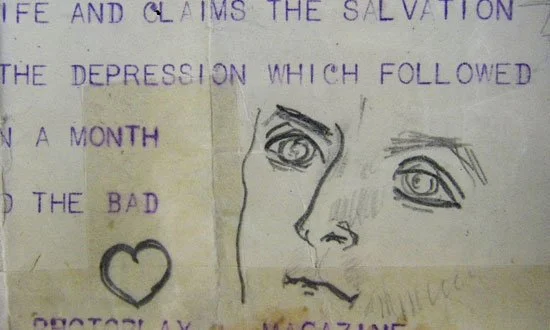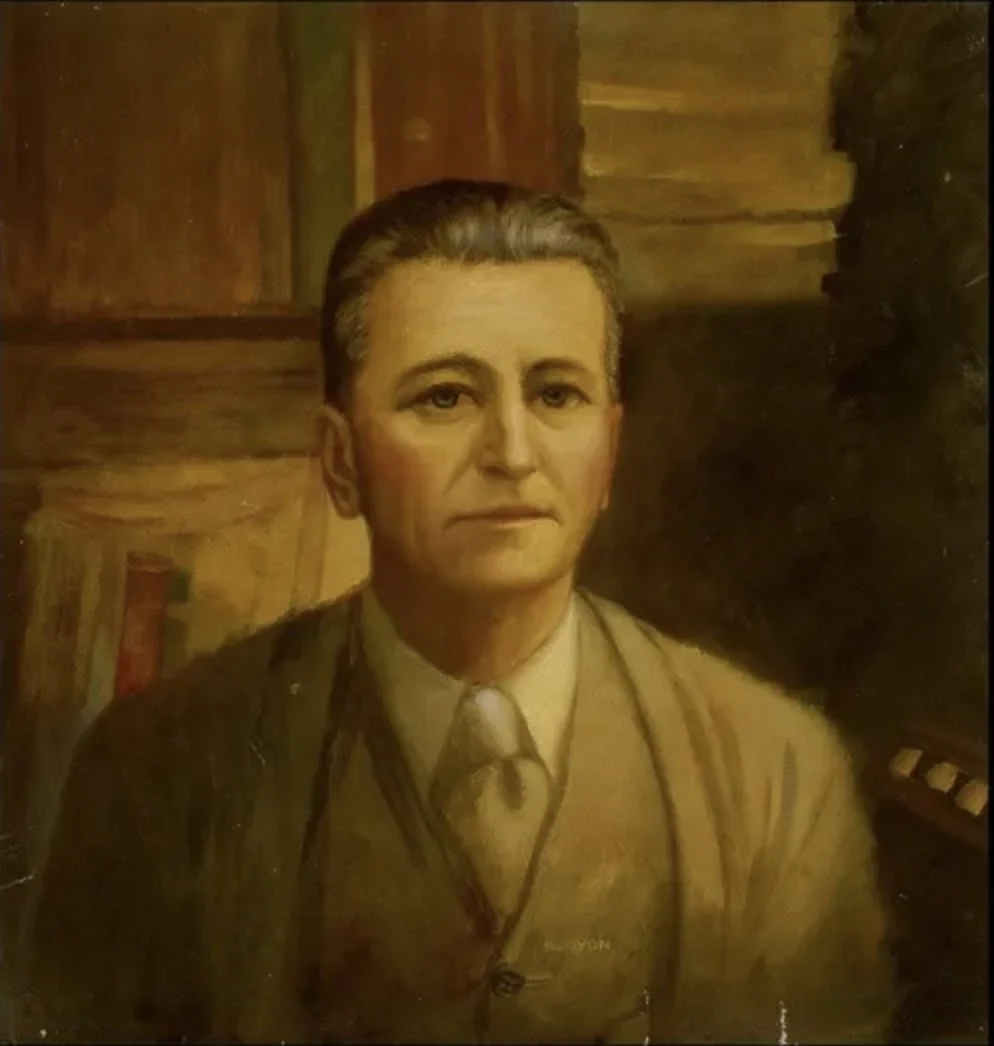"Double Time for Pat Hobby," A 1940 Story by F. Scott Fitzgerald, Is Published in The New Yorker
portrait of F. Scott Fitzgerald in Hollywood, early 1927, by Zelda Sayre Fitzgerald © Princeton University Libraries
Today The New Yorker printed the latest installment of their summer Flash Fiction series—a previously unpublished Pat Hobby story by F. Scott Fitzgerald, under the title “Double Time For Pat Hobby.” Fitzgerald wrote this story, to which he had not given a title, in the summer of 1940, some six months before his death. He was living in Hollywood at the time, and, while still working from time to time as a screenwriter—the profession also of Pat Hobby—he was spending more and more time on his novel in progress, The Last Tycoon.
Like The Last Tycoon, the Pat Hobby stories are LA stories, set in the movie world. Fitzgerald was both intrigued and compelled by “motion pictures.” The movies came of age as he did, during the nineteen teens; and in the 1920s he sold the screenplay rights to some of his popular stories and novels, and saw many of them produced and on the silver screen (some he liked; and some, like the 1926 movie of The Great Gatsby, starring Warner Baxter and now believed to be lost, he didn’t).
Fitzgerald first went to California in early 1927, with his wife Zelda Sayre Fitzgerald (their daughter Scottie stayed in Washington, DC with Scott’s parents and her English nanny). The Fitzgeralds spent three months in the Ambassador Hotel, with John Barrymore as a neat-bungalow neighbor, while Scott worked on a screenplay for Constance Bennett. Entitled “Lipstick,” Fitzgerald’s screenplay was a “college humor” piece about an enchanted tube of lipstick that made its wearer irresistible. The movie was never made; and “Brooklyn Connie,” a huge silent star but with the distinctive accent that gave her her nickname, quit Hollywood with the advent of the talkies, by 1929, and became a real estate mogul.
Fitzgerald in Hollywood, late 1931-early 1932, by Hal Bayard Runyon
In late 1931, Fitzgerald returned to Hollywood and this time worked on a screenplay for Joan Crawford. This movie, “Infidelity,” didn’t get made either, because the topic was too hot for 1938. Likely Crawford’s own well-publicized infidelities (her bitter rival Bette Davis famously said that Crawford had “slept with every male star at MGM except Lassie”) didn’t help matters. Fitzgerald swore he’d never go to Hollywood again. Yet in the summer of 1937, in need of money and offered a very lucrative contract from MGM, he did. He would spend the rest of his life in the Los Angeles area.
Fitzgerald and Sheilah Graham, Encino, California, 1939
While he worked on screenplays including that for Gone With the Wind (he added some dialogue) and Three Comrades (his sole screen credit), Fitzgerald also began writing a series of short stories about a Hollywood screenwriter named Pat Hobby, immensely successful in the 1920s and down on his luck in the 1930s. He sold the stories to Arnold Gingrich, his old friend and by 1939 the editor of Esquire, for $250 each. Seventeen Pat Hobby stories were published in Esquire in 1940 and 1941. Now, an eighteenth joins them in The New Yorker.
If you’ve not had the pleasure of meeting him before, Patrick J. Hobby is the star, generously speaking, of Fitzgerald’s last cycle of stories (for other cycles, see Basil Lee, Josephine, and Gwen). The Pat Hobby stories were written from mid-September 1939 until Fitzgerald’s death in December 1940. Pat Hobby is a 49-year-old washed-up hack screenwriter of Irish-American heritage, living in Fitzgerald’s present-day Hollywood. He was famous not so long ago, back in the 1920s, when the movies were silent and the Jazz Age was swinging. Now Pat generally has red-rimmed eyes and a “purr of whiskey” on his breath, but he’s always ready to say yes to the infrequently offered job. He’s hard-working, lazy, bold, afraid. Divorced at least twice; the father of, possibly, one son, about whom he found out when the boy was almost grown. A “liverish eye” for the ladies. A poor lover. Anticipating and dreading the future, nostalgic about the past. Sentimental about Christmas, past glories, and women in tears. Very fond of gin, horse racing, the idea of romance, football, “[c]ash, cars, girls, swimming pools[.]”
Pat is a scoundrel, but an appealing one. The repeated failure of his would-be blackguard moves keeps him relatively non-toxic. His coarse interior thoughts and prejudices, his ruminations about the secretary he might have slept with awhile ago but can’t really remember, the disregarded discarded wives and putative child, the petty attempted blackmails, the ugly lecherous behavior in an artist’s studio, could make of another character a villain. But Pat isn’t, because he is a failure. Pat surely ends up a man more sinned against, by the fates and the corrupt, mendacious, fickle Hollywood culture, than sinning.
Too long regarded as hack work for money because Fitzgerald did need the money at the time, and because they’re stories about a hack, the best of the Pat Hobby stories are beautifully made. “The Homes of the Stars,” “Fun In An Artist’s Studio,” “A Man In the Way,” and “Boil Some Water—Lots Of It!” belong in any selection of Fitzgerald’s best stories. Yet to break up the Pat Hobby stories feels wrong; as early as October 1939, Fitzgerald had wondered about publishing all the stories he had on hand at once, asking Gingrich if “the Pat stories would be effective if published in one issue” of Esquire. In 1962, with the approval of his daughter Scottie Fitzgerald Lanahan, Gingrich supplied an introduction for a Scribner edition of the seventeen Pat Hobby stories that had appeared in Esquire, in the order and as printed in the magazine.
There remain several incomplete drafts and notes for Pat Hobby stories in the Fitzgerald Papers at Princeton University. However, there is only one complete, previously unpublished Pat Hobby story of which I know. It exists in a single untitled typescript, filed in the Fitzgerald Papers for many decades with unrelated materials. It is undated, but was almost certainly written during the summer of 1940. It now bears the title “Double Time For Pat Hobby.” I identified it as a complete Pat Hobby story when I found the pages, filed at the time with other unrelated typescripts, back in 2018, and thanks to the Trustees of the Fitzgerald Estate, this last Pat Hobby story has now been published.
In “A Man In the Way” (Esquire, February 1940) Pat tells the young screenwriter Pricilla Smith to submit a story idea to a producer, and she demurs, since she’s under contract already for something else. He advises her to just “use another name.” Hollywood screenwriters worked in the 1930s in what we term today a gig economy. Hired by a studio to work on one screenplay, or for a particular length of time, a writer was bound by contract to that studio for the specified job or length of time. Pat’s advice to write under a pen name to circumvent a contract is dishonest, yet he states it matter-of-factly. Evidently, screenwriters must have done just this, and the double-dipping is central to the plot of “Double Time For Pat Hobby.” There’s an interesting synchronicity here, perhaps, with Fitzgerald wanting to publish in Esquire under the pseudonyms Paul Elgin and John Darcy. One must wonder if there are screenplays from 1939 and 1940, on which Fitzgerald worked under an assumed name, that have yet to be identified as his in part.
On June 7, 1940, Fitzgerald wrote to Scottie from his new Hollywood address at 1403 Laurel Avenue: “Did you see that Lehman [Herbert H. Lehman, governor of New York from 1933-1942] has called for anti-aircraft defense for New York? What a cowardly panic! Next we will have Louis B. Mayer calling for antiaircraft guns to defend Metro.” Evidently amused at this idea, Fitzgerald begins “Double Time For Pat Hobby” with it. The nervous producer DeTinc is clearly based on Louis B. Mayer. DeTinc also features as “a power in pictures” in “Fun In An Artist’s Studio” (Esquire, February 1941, but written in June 1940). In “Double Time For Pat Hobby,” DeTinc’s doctor is a regular presence in his offices. Mayer, a hypochondriac, saw a doctor every day, and compulsively recommended doctors to his actors and other employees.
Apart from neurotic producers, other elements of the Pat Hobby stories are firmly here as well: Pat’s drinking; his love of the Santa Anita racetrack and betting on horses via Louie, the studio bookie; pretending he still has an agent; and his envy of former writers reaching the pinnacle of being named producers on a movie. This is Pat’s fondest dream: getting a title and film credit without having to work much, or at all, and having—as a later idiom, of which Pat would have approved, put it—money for nothing and your chicks for free. “Double Time For Pat Hobby” certainly belongs in the company of its published predecessors.
This final Pat Hobby story will invite us to revisit the others we already cherish. They’re perfect summer reading. Andrew Turnbull, who knew Fitzgerald from his childhood (when Scott, Zelda and Scottie were living in “La Paix,” a family home of the Turnbulls’ in Rodgers Forge, Maryland), reviewed the 1962 Pat Hobby collection for The New York Times, and no one has since described Pat Hobby’s merits better:
The seventeen stories in this volume are short—their author was short-winded and hoarding his strength for his novel—but they are the work of a master hand. The prose is lean, swift and deadly accurate. The tone is typical of Fitzgerald after his crack-up: utterly detached, stripped of all illusion, yet compassionate enough to win sympathy for a protagonist who is essentially a rat—and reveals it in such stories as ‘Pat Hobby’s Christmas Wish’ (a foredoomed scheme to frame a producer) and ‘Pat Hobby’s College Days’ (a disastrous attempt to capture a campus prank in a scenario). Other stories, like ‘Pat Hobby’s Secret’ and ‘The Homes of the Stars’ are agonizingly funny, and throughout the book the irony, the little curls of humor keep one smiling. If these aren’t the greatest stories Fitzgerald ever wrote, they are important to an understanding of his career, and they belong to the small company of works that genuinely evoke Hollywood.
© Anne Margaret Daniel 2025


